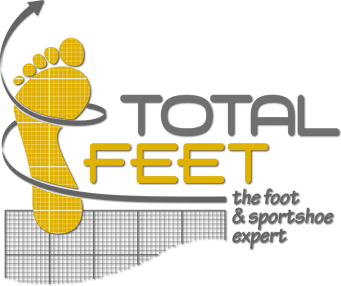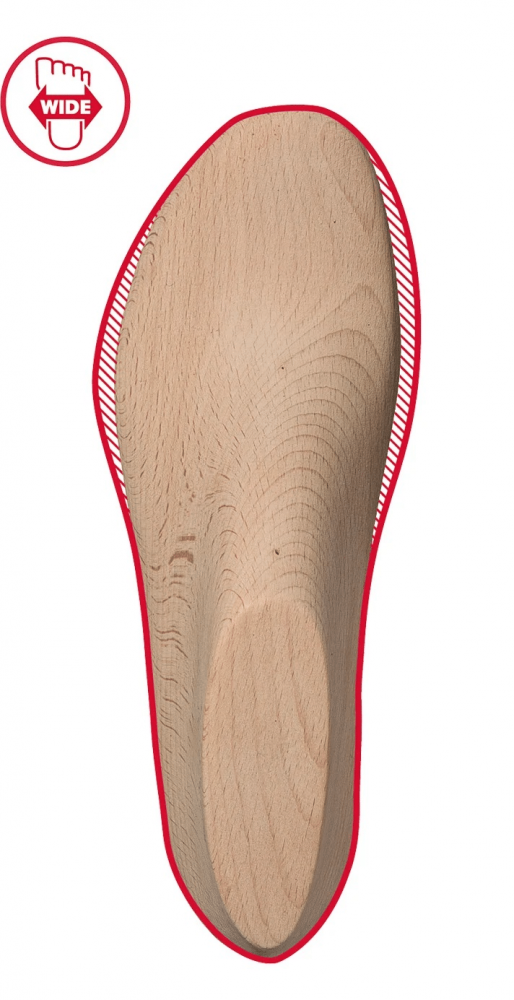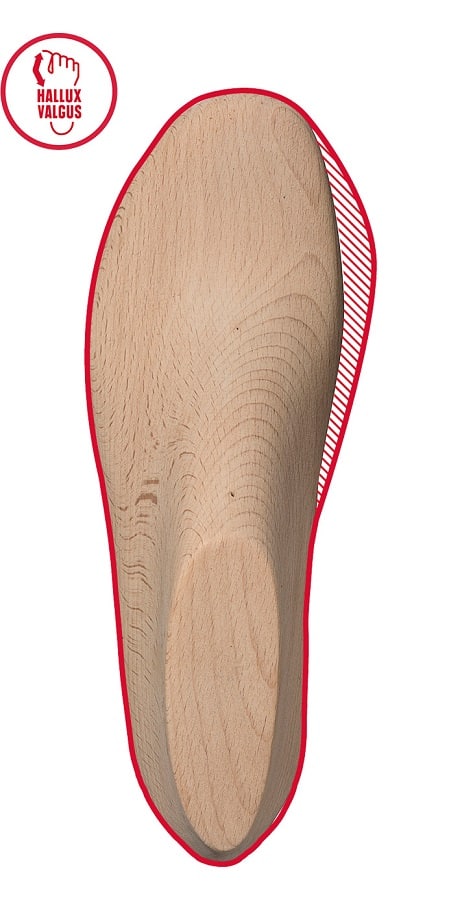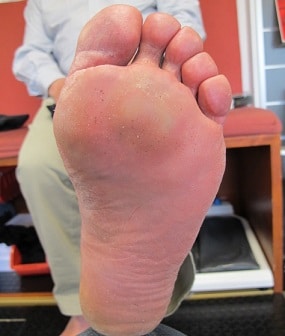All feet are different! We know that.
Each season has its particular problems! Whether it’s winter with ski boots or summer hiking, the same ones will reappear
I have a wide to very wide forefoot
Whether for men or women, the width of the forefoot very often comes into conflict with the front zone of the shoe, after 3-4 hours of walking: The transverse arch of the forefoot needs room in the width of the forefoot to allow the foot to move into the propulsive phase (forward step). The forefoot is “strangled” by the shoe. Your walking gait is unsure, even painful.
Many people voluntarily wear shoes that are too big to reduce this problem. This only shifts the problem: the heel is no longer maintained in the rear part of the shoe, lack of support for the ankle, appearance of blisters, etc.
Solution: choose your shoe according to your morphology
TOTAL FEET has selected models from HANWAG especially made in Wide as well as from Scarpa that will suit you.
If necessary, our workshop is also specially equipped to increase the volume of footwear around the forefoot by deformation.
All you need is to leave us the shoes for 24 hours in order to stretch them accordingly on our soft leather stretchers
My Hallux valgus is making my hikes impossible after a couple of hours ( as sometimes even less)
Hallux valgus known also as “bugnion”, whether congenital or adaptive, is a deformity of the 1er radius of the foot causing the big toe to deviate towards the outside of the foot. The structure of the forefoot is modified with a protruding and deformed surface of the big toe joint. Calluses appear on the skin. This friction can create an inflammation of the envelope of the metatarsophalangeal joint (bursitis) and the “bunion” becomes red, hot and painful.
In short, depending on the type of shoe, walking can become problematic and painful. It is necessary to find a walking shoe that allows enough room at this location, without being too big on the rest of the foot.
Solution:
1- First of all, you have to unload the 1er radius. Very often a custom-made sole with a consistent arch support is needed to rebalance the support of the anterior arch.
2-Select a shoe that corresponds in size and volume to your particular shape. A shaping will be necessary in order to relieve the constraints on the concerned joint
Total Feet recommends HANWAG mountain boots, which have designed models for people with hallux valgus. The shoes have been constructed with a specially generous shape on the inside of the shoe at this joint. They are lined on the inside with leather with no seams in the area of the hallux valgus. This avoids friction in this area. If necessary, our workshop can shape the shoes to better fit this area.
Approach low for mn’s and Wn’s Banks Bunion https://www.total-feet.com/en/gamme/banks-low-copy/
Hiking boots for Women Tatra II bunion https://www.total-feet.com/en/gamme/tatra-bunion/
burning sensation under the forefoot after 2 hours of walking to the point of removing shoes and massage the soles of the feet
Many people face this problem. Several factors can cause it. Let’s review them
- Do you already have the right shoe?
The sole should be stiffer than a tennis or running shoe. If the shoe bends too easily in the forefoot, the foot has to make efforts to compensate for this weakness in the shoe. There is thus an overload at the level of the transverse arch of the foot (under the metatarsal heads)
Do you have enough room in the shoe for the forefoot? If not, your forefoot is too tight, the transverse arch cannot function normally, especially after 2-3 hours of walking (the foot swells) or when going downhill
- I feel good in my shoes, but I have to take them off to massage the forefoot
A thorough examination of the morphology of the feet and assessment is necessary. Generally, it is necessary to make a pair of custom-made insoles in order to rebalance the natural structure of your feet. The goal is to allow the 3 natural arches of the foot to act as a shock absorber, and to relieve the overloads of the forefoot
Solutions Orthopedical assessment, detailed foot measurements, examination of shoes. Deformation and shaping in our SHOELAB workshop
TOTAL FEET will also provide the right advice and choice of the most appropriate model from our range of hiking boots
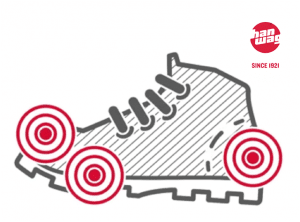
Heel rubbing in the shoe and heel blisters
The most unpleasant problem in walking, whatever the sport and even in everyday life. It is one of the first concerns of all hikers, whether in the forest or on mountain trails. Through this section, we will discover that once again, it is not a fatality, but some rules to respec
- Why do we have blisters? What’s going on?
Almost every hiker knows this common problem: What starts out as a slight chafing sensation and heat can quickly turn into a painful blister on the inside of your socks.
Blisters can have several causes:
– Shoes that are not adapted to your morphology and foot size
– Socks not adapted, folds, or sewing which rubs
– Presence of foreign bodies dust, sand, in the shoe or in the sock
– Friction caused by an excessive perspiration in the shoe
TOTAL FEET will assist you with
-a complete orthopedical assessment, detailed foot measurements, examination of your current footwear
-Advice and choice of the most appropriate model in our range of hiking boots
– Custom shoe last modification to measure in our SHOELAB workshop
If necessary, manufacture of custom-made insoles according to the podological assessment for hiking boots
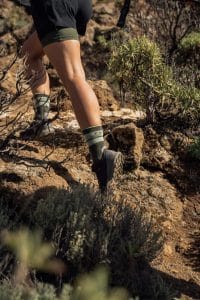
Pain along the shin and/or knee that occurs during descents
The body rebels, calls for help. It is a mechanical problem that our skeleton and muscular chain cannot compensate. These pathologies lead to a more or less long stop of the sport practice, with generally physiotherapy sessions. Some recommendations to prevent any risks during your mountain hikes
Pain along the tibia
When hiking, the main risk factor for tibial periostitis is walking downhill. When walking downhill, the muscles are forced to absorb the energy imposed on them when they hit the ground. It is this heavy and repeated impact that can lead to the development of tibial periostitis. Several factors must be taken into account: our height, weight, physical condition, the profile of the course, the surface of the ground, especially during descents
The shoes: They must have a good profile that will ensure safe contact and grip when we put our foot down. The
midsole (between the rubber and the bottom of the foot) must be able to provide cushioning when the heel touches the ground (heel
support), but stiff enough to ensure stability in torsion over the entire length of the shoe: the foot can remain flat without turning inwards.
The foot must be well maintained by the envelope of the shoe without attacking it. This envelopment allows the foot to be better maintained and accompanied in the different phases of support of the foot. Many people still suffer from this problem with shoes such as sneakers or running shoes. Their midsole does not provide this stability.
If you use mountain boots with a rigid sole in order to be able to use semi-automatic or automatic crampons, the sole of the boot is much too stiff and may trigger pain in the shins.
The use of walking sticks during the descent is essential: we pass from biped to quadruped: 4 points of support on the ground instead of 2 = a better distribution of the supports and distribution of the load between the feet and the sticks.
Another important point is your anatomical structure in the plantar musculature.
In many cases, the foot needs to have a custom-made support in order to create an internal arch of unwinding. The function of this sole is to stabilize the foot, allowing our bone chain of the foot and ankle to remain in a natural position when walking.
Knee pain Just like shin pain, the knee usually suffers from mechanical weakness. The same advice is recommended for both shoes and poles. Nevertheless, a complete body- foot balance and static assessment , a custom-made foot support compensating to your problem.
Total Feet will be able to create a thermoformed sole for your hiking boots, entirely made to measure. After a morphological and dynamic assessment and the addition of corrective elements if necessary, the thermoformed insole will replace the original insole of your shoes.
